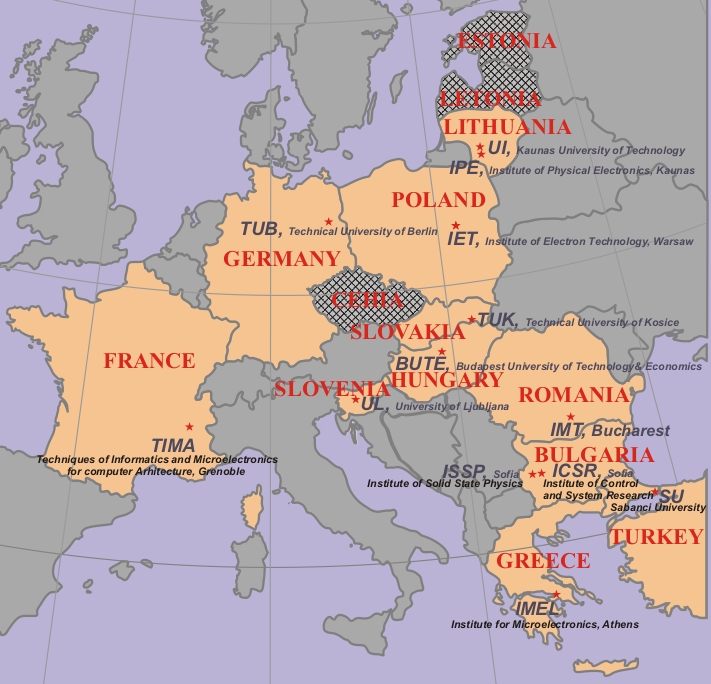|
|
HOME
MINAEAST-NET
MIcro and NAnotechnologies going to EASTern Europe through NETworking
Secific Support Action
Coordinator: National Institute for Research and Development in Microtechnologies, Ro;
Prof. Dan Dascalu (dascalu@imt.ro)
MICRO AND NANOTECHNOLOGIES BULLETIN
Vol. 5/No. 1; p 6, p 7
The aim of the network MINAEAST-NET is to develop a concerted effort for preparing the participation of ACC's to projects in FP6 on Micro and Nano Technologies (MNT). The subject involves the priority thematic areas 2. IST and 3. NMP. In order to have a unifying idea, the approach called Concurrent Engineering is used, because this means to take into account, even at the design stage all the elements concurring to the quality & reliability of the product: manufacturing, modelling & simulation, characterization, testing and reliability. MINAEAST-NET will be a network of networks formed by research bodies from several ACCs (core members of the network), which are coordinators of local networks formed by national high quality centres of research (associated members of the network), active in MNT. Also, key partners from MS, ensuring important links in the field, are core members of MINAEAST-NET.
The network will give the answer to three questions about MNT:
- Who are the ACC most qualified research groups to co-operate with MS? MINAEAST-NET will be a premier source if MS organisations (research and industry) need partners in ACC for MNT projects.
- What ACC teams must know about FP-6? MINAEAST-NET will support ACC members to get the right information and to contact MS partners.
- How to build properly a proposal for FP-6? MINAEAST-NET will help in offering to ACC researchers training and consultancy in preparing proposals, but also in structuring consortia.
All above objectives will be measured in later reviews and assessments, in order to certify the progress of the project work.
Developments of MINAEAST-NET are a preview in two ways:
i) as Concurrent Engineering may be used for any product, the subject of activity will be enriched with other items from 2. IST and 3. NMP
ii) research bodies from other ACCs will be attracted in the network.
MINAEAST-NET is focused on the following objectives, grouped on two main actions, referring to: networking & dissemination and proposal preparation, respectively.
MINAEAST-NET will be established as the premier source of information about resources and results in MNT from ACCs and about the strong points of the ACC organisations.
Organisations and companies from MS (and world-wide) that are looking for partners in MNT for any kind of projects, should address their needs to MINAEAST-NET and MINAEAST-NET will definitely find the best partner suited for them. This activity is mainly addressed to FP 6 projects, but also to any other kind of cooperation in research or commercial activities.
For all MNT interested organisations from ACC, MINAEAST-NET will be the main source of MNT specific project&partnership information: MNT related information about EC calls, international networking activities, partnership search from abroad.
MINAEAST-NET will support interaction between ACC and MS organisations to initiate FP6 proposals through organising meetings, workshops and support travel cost.
MINAEAST-NET will also be the "little helper" with any questions concerning proposal set-up and regulations for ACC organisations – all that especially for MNT. For any general questions from ACC, MINAEAST-NET will have the contacts to get them answered within other NCPs or support organisations that already exist.
MINAEAST-NET participants:
 The coordinator of the MINAEAST-NET project - National Institute for R&D in Microtechnologies (IMT-Bucharest). Contact: Prof. Dan Dascalu (dascalu@imt.ro); Dr. Carmen Moldovan (cmoldovan@imt.ro ). The coordinator of the MINAEAST-NET project - National Institute for R&D in Microtechnologies (IMT-Bucharest). Contact: Prof. Dan Dascalu (dascalu@imt.ro); Dr. Carmen Moldovan (cmoldovan@imt.ro ).
 Budapest University of Technology & Economics (BUTE). Contact: Dr. MᲴa Rencz (rencz@eet.bme.hu). Budapest University of Technology & Economics (BUTE). Contact: Dr. MᲴa Rencz (rencz@eet.bme.hu).
 University of Ljubljana, Faculty of Electrical Engineering (UL-FE). Contact: Prof. dr. Slavko Amon (slavko.amon@fe.uni-lj.si). University of Ljubljana, Faculty of Electrical Engineering (UL-FE). Contact: Prof. dr. Slavko Amon (slavko.amon@fe.uni-lj.si).
 Institute of Control and System Research (ICSR). Contact: Prof. Chavdar ROUMENIN (roumenin@bas.bg). Institute of Control and System Research (ICSR). Contact: Prof. Chavdar ROUMENIN (roumenin@bas.bg).
 Institute of Solid State Physics of the Bulgarian Academy of Sciences (ISSP). Contact: Dr. Anna M. Szekeres (szekeres@issp.bas.bg). Institute of Solid State Physics of the Bulgarian Academy of Sciences (ISSP). Contact: Dr. Anna M. Szekeres (szekeres@issp.bas.bg).
 Institute of Physical Electronics (IPE) of Kaunas University of Technology. Contact: Prof. Sigitas TAMULEVICIUS (Sigitas.Tamulevicius@ktu.lt). Institute of Physical Electronics (IPE) of Kaunas University of Technology. Contact: Prof. Sigitas TAMULEVICIUS (Sigitas.Tamulevicius@ktu.lt). |
 |
 Kaunas University of Technology (KTU). Contact: Dr. Elena Jasiuniene (elena.jasiuniene@ktu.lt). Kaunas University of Technology (KTU). Contact: Dr. Elena Jasiuniene (elena.jasiuniene@ktu.lt).
 Technical University of Kocice (TUK). Contact: Prof. Sv䴯boj Longauer (Svatoboj.Longauer@tuke.sk). Technical University of Kocice (TUK). Contact: Prof. Sv䴯boj Longauer (Svatoboj.Longauer@tuke.sk).
 Sabanci University (SU). Contact: Prof. Yasar GURBUZ (yasar@sabanciuniv.edu). Sabanci University (SU). Contact: Prof. Yasar GURBUZ (yasar@sabanciuniv.edu).
 Institute of Microelectronics (IMEL) / NCSR "Demokritos". Contact: Dr. Androula NASSIOPOULOU (A.Nassiopoulou@imel.demokritos.gr). Institute of Microelectronics (IMEL) / NCSR "Demokritos". Contact: Dr. Androula NASSIOPOULOU (A.Nassiopoulou@imel.demokritos.gr).
 Techniques of Informatics and Microelectronics for computer Architecture (TIMA). Contact: Dr. Bernard Courtois (Bernard.Courtois@imag.fr). Techniques of Informatics and Microelectronics for computer Architecture (TIMA). Contact: Dr. Bernard Courtois (Bernard.Courtois@imag.fr).
 Technical University of Berlin (TUB). Contact: Prof. Herbert Reichl (herbert.reichl@tu-berlin.de). Technical University of Berlin (TUB). Contact: Prof. Herbert Reichl (herbert.reichl@tu-berlin.de).
 Institute of Electron Technology (IET). Contact: Dr. Piotr GRABIEC (grabiec@iet.waw.pl). Institute of Electron Technology (IET). Contact: Dr. Piotr GRABIEC (grabiec@iet.waw.pl).
Web page: www.minaeast.net |


